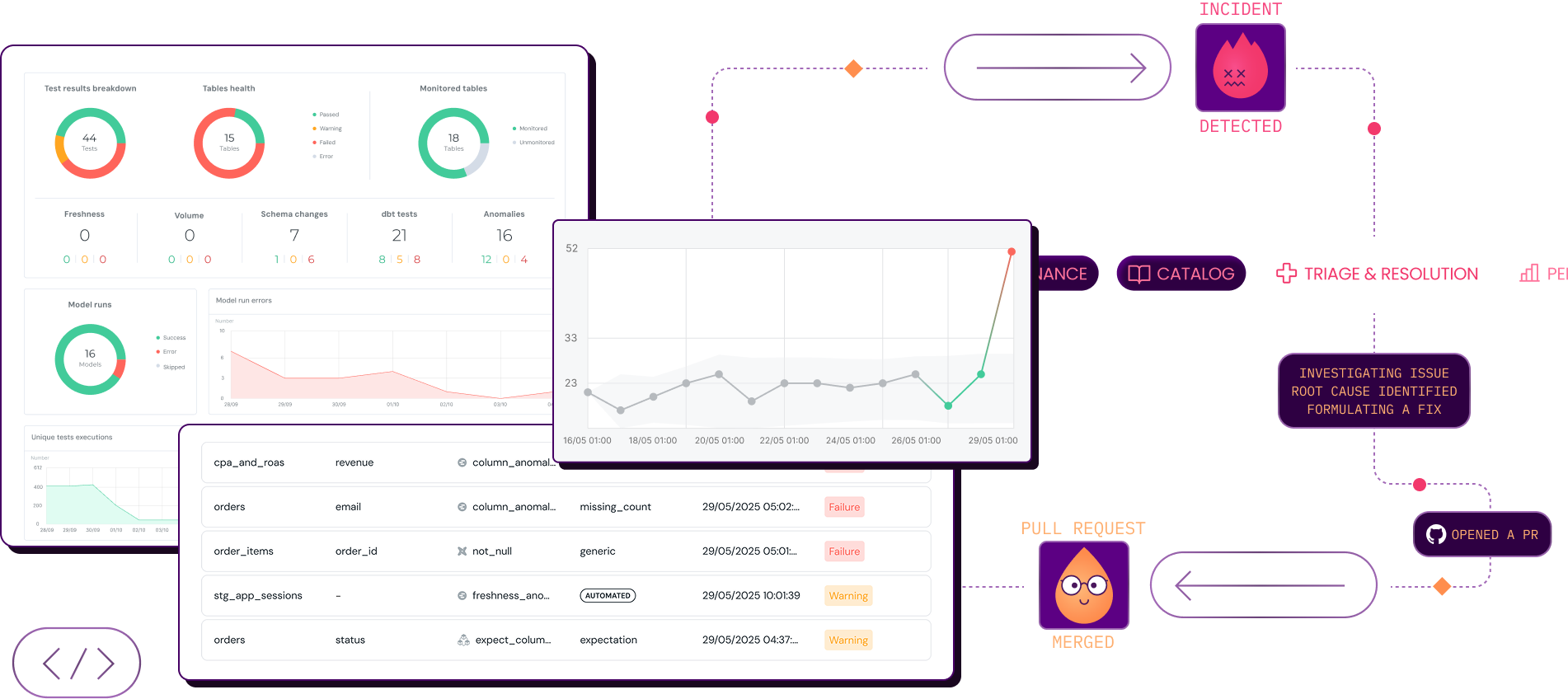Dev-First
AI-Powered
Data Observability
Elementary is built for and trusted by
1000+ analytics and data teams.
What is Elementary?

Detect anomalies
Detect anomalies in your dbt models with tests for freshness, volume, and your customizable data metrics.
ML-powered pipeline monitoring
ML-powered monitors automatically detect data quality issues. Out-of-the-box for volume and freshness, and opt-in for data quality metrics.
Validate and track dbt test results
Validate data and track the results of dbt tests, dbt packages tests (dbt-utils, dbt-expectations, elementary) and custom SQL tests.
Validate schema and downstream exposure
Validate there are no breaking changes in tables schema, JSON schema, and downstream exposures such as dashboards.
Configure in code or UI, bulk add tests
Configure Elementary in code, or via the UI for non-technical users or for adding tests in bulk. The platform opens PRs to your repo, saving hours of tedious YAML edits.
Manage test coverage
See the full picture of your test coverage across assets and dimensions. Easily identify gaps and prioritize coverage for critical assets.
Test recommendation AI agent
Analyzes your data asset, metadata, lineage, and existing test suite to suggest high-impact tests that match your team’s style and priorities.
Send alerts, analyze lineage
Send alerts for data quality issues and understand their impact.
Column-level lineage and impact analysis
Column-level lineage from source to BI. Enables granular root cause and impact analysis.
Highly configurable alerts and integrations
Distribute highly configurable alerts to different channels and integrations. Automatically tag owners, and enable setting status and assignees at the alert level.
Incident management system
Manage all open quality incidents in a single interface, with a clear view of status and assignees.
Triage & resolution AI agent
Automates root cause analysis, clarifies the impact, and suggests actionable fixes.
Allow business users to monitor and maintain their data
Overview dashboard
Up to date dashboard with current status and trends of data issues. Share the dashboard with others, enable them to slice results and stay informed.
Data catalog
Curate a collaborative, AI-enriched catalog with smart metadata editing, critical asset tagging, and analyst-first discovery tools.
Data health scores
See the Data Health scores of all your datasets by domain and share with stakeholders.
Configure tests in the UI
Allow business users to configure tests in the UI, without needing to write YAML or SQL.
Catalog AI agent
Helps data analysts, business users, and AI tools find the right data on their own so engineers don’t have to be the bottleneck.
Display tags, owners and subscribers
Visualize and edit your assets' tags, owners and subscribers, as they are in your code
Marking critical assets
Easily mark your company's crucial assets as critical, and give higher priority in monitoring and alerting to any issue that might impact them.
Efficiently add tags, owners and subscribers
Edit your assets' tags, owners and subscibers in a bulk to ensure structure and the right work distribution
Metadata management
Manage your metadata efficiently, directly from the Elementary Catalog
AI descriptions
Let the AI agent generate high-quality asset descriptions that align with your existing documentation and company policies.
Governance AI Agent
Let the AI agent keep your catalog complete and compliant by filling metadata gaps, enforcing policies, and flagging sensitive data issues.
Integrations
Connect Elementary to every part of your data stack—from your warehouse to BI, incident management and messaging tools.
Check out the integrations
OSS integrations
Cloud integrations
Get started now
Whether you need a lightweight start or an enterprise-ready platform, Elementary has a solution for you.
Featured guides
Learn from the Elementary team and thousands of users from our community how to set up effective, scalable data observability.
Join the community
Join the Elementary Community for AI and team support, explore best practices, and stay up to date on OSS and Cloud. Connect with other data professionals and help shape what’s next.
Join now

